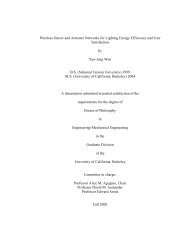Metaphors in Conceptual Design - Berkeley Expert Systems ...
Metaphors in Conceptual Design - Berkeley Expert Systems ...
Metaphors in Conceptual Design - Berkeley Expert Systems ...
Create successful ePaper yourself
Turn your PDF publications into a flip-book with our unique Google optimized e-Paper software.
examples. The l<strong>in</strong>guistic nature of the doma<strong>in</strong> makesquantitative analysis difficult if not mislead<strong>in</strong>g at times.<strong>Design</strong> textbooks are a fruitful source of study as they holdsome of the greatest potential to <strong>in</strong>fluence design teach<strong>in</strong>g andculture. We conf<strong>in</strong>ed our analysis to chapters that dealtprimarily with conceptual design, <strong>in</strong>clud<strong>in</strong>g concept generation,for two reasons. First, these chapters generally conta<strong>in</strong> thehighest density of discussion of the more abstract concepts <strong>in</strong>design and are thus a richer and more concentrated source ofmetaphors than other chapters on the design process. Second,we are <strong>in</strong>terested <strong>in</strong> how the metaphors <strong>in</strong> use affect ourcapacities for creative design and much of the creative phase ofdesign is generally considered <strong>in</strong> this step. While creativeactivity can happen just as often outside of the conceptualphase, discussion of this creative activity occurs significantlyless. For example, later chapters may show similar metaphorsto those found <strong>in</strong> our analysis but the density of the <strong>in</strong>stanceswith<strong>in</strong> the text is much less with more discussion of otherconcepts such as risk or test<strong>in</strong>g. In our discussion we also drawfrom some widely used metaphors about design to support ourconclusions.Two researchers collectively identified and coded nearlyfour hundred unique <strong>in</strong>stances of sentences or phrasesconcern<strong>in</strong>g design or key design concepts. A protocol wasdeveloped to enable the two researchers to reliably identify thesame examples over identical sources. A test cod<strong>in</strong>g the samechapter from a randomly selected textbook yielded 88%agreement between the <strong>in</strong>stances selected.Cod<strong>in</strong>g <strong>in</strong>volved label<strong>in</strong>g each <strong>in</strong>stance with the associateddesign concepts – the Target doma<strong>in</strong> of any underly<strong>in</strong>gmetaphor (e.g. Ideas, Problems, Solutions…). Once sufficient<strong>in</strong>stances of each Target doma<strong>in</strong> were identified, the researchersidentified metaphors that provide coherence to each of the<strong>in</strong>stances.Table 3 shows an example of an extracted <strong>in</strong>stance and thecodes applied to it. The sentence refers to three dist<strong>in</strong>ct targetdoma<strong>in</strong>s: (1) the design concepts of ideas; (2) solutions; and (3)problems. Each design concept is referred to metaphorically.The example <strong>in</strong> Table 3 illustrates how each of these targetdoma<strong>in</strong>s is qualified <strong>in</strong> some way: ideas can be triggered offand can be spontaneous; solutions can be ready-made andproduced (even if bra<strong>in</strong>storm<strong>in</strong>g can’t do that); and problemscan be complex and solved (or <strong>in</strong> this case, difficult to solve).Many design concepts are not abstract entities; they have avery real existence. So while we can refer to a <strong>Design</strong> SketchAs A Tool, the sketch itself is not abstract, it has a very realphysical form. These tangible concepts, <strong>in</strong>clud<strong>in</strong>g sketches,matrices, decisions and such, were not <strong>in</strong>cluded <strong>in</strong> our analysisor cod<strong>in</strong>g scheme as their roles are more clearly understoodthan the abstract concepts of design ideas, problems, solutionsand such.TABLE 3: CODING EXAMPLESource Instance CodesPahl andBeitz,SystematicEng<strong>in</strong>eer<strong>in</strong>g<strong>Design</strong>, [32]Bra<strong>in</strong>storm<strong>in</strong>g is meantfirst of all to trigger offnew ideas, but itcannot be expected toproduce ready-madesolutions becauseproblems are generallytoo complex and toodifficult to be solved byspontaneous ideasalone.IdeasSolutionsProblemsPhase 2: Categorization metaphor <strong>in</strong>stancesOnce the metaphor statements were collected we began asort<strong>in</strong>g process where we first grouped <strong>in</strong>stances of the sametarget doma<strong>in</strong>, for example, collect<strong>in</strong>g all the sentences thatreferred to ‘problems’. We then listed all the qualify<strong>in</strong>gstatements for each Target doma<strong>in</strong> <strong>in</strong> the form ‘Ideas can be,ref<strong>in</strong>ed, polished, amassed, shared, bounced around…’ Thetables produced as the outcome of this phase illustrate theaffordances [35] each design concept possesses.Phase 3: Identification of coherent metaphorsThe next stage was to identify suitable metaphors thatexpla<strong>in</strong>ed as many of the <strong>in</strong>stances as possible. This phase wasconducted as a series of cluster<strong>in</strong>g steps, <strong>in</strong> each step gather<strong>in</strong>gtogether affordances that highlighted similar properties. Forexample ideas can be handed to other team members and canalso be bounced off them. Both of these affordances support themetaphor Ideas Are Physical Objects.In almost all cases each Target Doma<strong>in</strong> was mapped toseveral different source doma<strong>in</strong>s depend<strong>in</strong>g upon the context ofthe statement, for example, Ideas are seen as both Food (“Ineed some time to digest what you said.”) and Products (“Thisidea needs to be ref<strong>in</strong>ed.”) Several metaphors, <strong>in</strong>clud<strong>in</strong>g IdeasAs Food and Ideas As Products, supported the metaphorsidentified previously <strong>in</strong> the literature (for example [2],[6]).Once metaphors were identified we analyzed the implicationsof the use of each metaphor <strong>in</strong> design.RESULTSIn this section we identify the most frequent metaphoricalconcepts employed <strong>in</strong> the design texts, as well as the mostfrequently used metaphors for each concept we found.Metaphorical concepts identifiedWe grouped the metaphorical concepts referred to <strong>in</strong> thedesign textbooks <strong>in</strong>to three categories sorted by frequency ofmention: Universal, Often and Occasional. Universal designconcepts <strong>in</strong>cluded references to design itself and the designprocess, ideas, concepts, problems and solutions. Concepts5 Copyright © 2007 by ASME
















